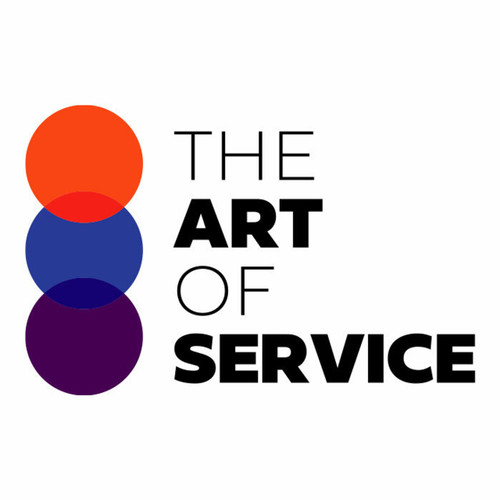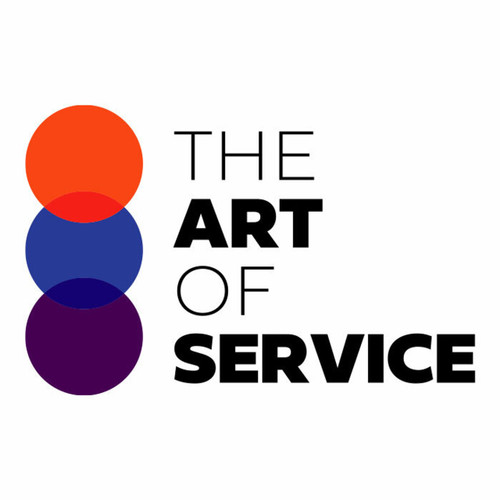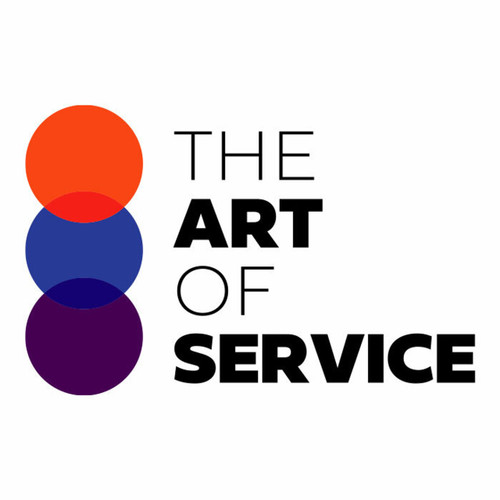Our comprehensive dataset contains over 1504 prioritized requirements, solutions, benefits, results, and case studies related to both capacity utilization and Shingo Prize.
These curated resources have been carefully selected to provide you with the most important questions to ask in order to achieve tangible results in a timely manner.
But what sets our Knowledge Base apart from competitors and alternative resources? It has been specifically designed for professionals like you who are looking for a quick and effective way to optimize their company′s performance.
Whether you are a small business or a large corporation, our product is tailored to meet the needs of all types of organizations.
But not only is our product user-friendly, it is also affordable and accessible for all.
Gone are the days of expensive consulting fees or complicated software programs.
Our DIY approach allows you to easily navigate the dataset and find the information you need without breaking the bank.
We provide a detailed overview of the product specifications and how it compares to semi-related products in the market.
With our Capacity Utilization and Shingo Prize Knowledge Base, you can rest assured that you are getting the most comprehensive and up-to-date information available.
But what are the benefits of using our product? Our research on Capacity Utilization and Shingo Prize has shown significant improvements in efficiency, cost savings, and overall business performance for companies who have utilized our resources.
Don′t just take our word for it - see for yourself by browsing our impressive list of case studies and use cases.
And the best part? Our product is not just limited to businesses.
Individuals and students interested in learning more about capacity utilization and Shingo Prize can also benefit from the wealth of information in our Knowledge Base.
So why wait? Don′t miss out on the opportunity to streamline your company′s processes and improve your bottom line.
Purchase our Capacity Utilization and Shingo Prize Knowledge Base today and watch your business thrive.
Discover Insights, Make Informed Decisions, and Stay Ahead of the Curve:
Key Features:
Comprehensive set of 1504 prioritized Capacity Utilization requirements. - Extensive coverage of 135 Capacity Utilization topic scopes.
- In-depth analysis of 135 Capacity Utilization step-by-step solutions, benefits, BHAGs.
- Detailed examination of 135 Capacity Utilization case studies and use cases.
- Digital download upon purchase.
- Enjoy lifetime document updates included with your purchase.
- Benefit from a fully editable and customizable Excel format.
- Trusted and utilized by over 10,000 organizations.
- Covering: Supply Chain Integration, Process Standardization, Process Documentation, Problem Framing, Rapid Improvement, Achievement Drive, Strategic Alignment, Efficiency Improvement, Aligning Priorities, Employee Involvement, Supply Chain Optimization, Productivity Improvement, Facility Layout, Workplace Organization, Material Flow, Strategic Planning, Service Suitability, Production Scheduling, Continuous Problem Solving, Cycle Time Reduction, Continuous Improvement, Customer Satisfaction, Quality Assurance, Business Strategy, Workforce Development, Lean Operations, Continuous Improvement Culture, Root Cause Analysis, Key Performance Indicators, Leadership Training, Leadership Alignment, Productivity Enhancement, Culture Of Excellence, Performance Measurement, Best Practices, Cost Effective Operations, Goal Setting, Inventory Management, Root Cause Elimination, Motivational Leadership, Continuous Monitoring, Change Management, Production Efficiency, Performance Tracking, Supplier Development, Eliminating Waste, Reduced Waste, Business Transformation, Quality Culture, Continuous Flow, Team Building, Standard Work, Cross Functional Teams, Cost Management, Quality Standards, Real Time Data, Error Proofing, Preventative Maintenance, Inventory Efficiency, Process Optimization, Visual Controls, Long Term Strategy, Waste Reduction, Takt Time Analysis, Process Visibility, Product Design, Strategic Partnerships, Continually Improving, Project Management, Supplier Performance, Gemba Walks, Risk Management, Production Environment, Resource Allocation, Error Detection, Vendor Management, Error Reduction, Six Sigma, Inventory Control, Management Systems, Visual Management, Total Productive Maintenance, Problem Solving, Innovation Management, Just In Time Production, Business Process Redesign, Supplier Selection, Capacity Utilization, Employee Recognition, Lean Practitioner, Defect Reduction, Quality Control, Supplier Relations, Value Added Processes, Equipment Maintenance, Employee Incentives, Continuous Learning, Supply Chain Management, Cost Reduction, Operational Excellence Strategy, Six Sigma Methodologies, Team Communication, Process Controls, Lean Management, Six Sigma, Continuous improvement Introduction, Employee Engagement, Design For Manufacturability, Training And Development, Waste Minimization, Manufacturing Excellence, Waste Elimination, Quality Management, Technology Integration, Root Cause Identification, Measurement Systems, Feedback Loops, Leadership Development, Kaizen Events, Kaizen improvement, Shingo Prize, Value Stream Mapping, Quality Certification, Employee Empowerment, Lean Assessment, Corporate Values, Value Stream Analysis, Line Balancing, Employee Training, 5S Methodology, Information Technology, Implementation Challenges, Process Improvement, Performance Excellence, Cost Control, Knowledge Sharing, Standardized Work
Capacity Utilization Assessment Dataset - Utilization, Solutions, Advantages, BHAG (Big Hairy Audacious Goal):
Capacity Utilization
Capacity utilization refers to the extent to which an organization′s resources and capabilities are being used effectively to produce goods or services.
Solutions:
1. Establish an ongoing measurement and analysis system for continuous improvement.
2. Implement systems to balance production with demand and identify bottlenecks.
3. Use lean tools such as value stream mapping to optimize workflow and eliminate waste.
4. Train employees on problem-solving techniques to improve productivity and efficiency.
5. Use visual management tools to clearly communicate goals and progress to all employees.
Benefits:
1. Increased productivity and efficiency.
2. Improved overall quality and customer satisfaction.
3. Reduced lead time and inventory costs.
4. Enhanced decision-making based on data analysis.
5. Engaged and knowledgeable employees leading to a culture of continuous improvement.
CONTROL QUESTION: Have experts within the organization looked at the work and agreed that the part is valid?
Big Hairy Audacious Goal (BHAG) for 10 years from now:
Our big hairy audacious goal for Capacity Utilization in 10 years is to achieve an overall utilization rate of 90% across all departments within our organization. This means that our experts have looked at the work being performed and have unanimously agreed that every part and process is valid and essential for our success.
We understand that in order to reach this goal, we must continually evaluate and optimize our operations to ensure maximum efficiency. This will require investments in advanced technology, employee training and development, and fostering a culture of continuous improvement.
We envision a future where our organization is a model of optimal capacity utilization, setting the standard for industry excellence and profitability. Not only will this benefit our bottom line, but it will also allow us to better serve our customers by delivering high-quality products and services in a timely manner.
With this ambitious goal in mind, we are committed to working tirelessly over the next 10 years to drive our capacity utilization to new heights and establish ourselves as a leader in the market. We believe that with dedication, collaboration, and innovation, we can make this vision a reality and take our organization to unprecedented levels of success.
Customer Testimonials:
"The creators of this dataset deserve applause! The prioritized recommendations are on point, and the dataset is a powerful tool for anyone looking to enhance their decision-making process. Bravo!"
"This dataset is a game-changer! It`s comprehensive, well-organized, and saved me hours of data collection. Highly recommend!"
"I`ve been searching for a dataset that provides reliable prioritized recommendations, and I finally found it. The accuracy and depth of insights have exceeded my expectations. A must-have for professionals!"
Capacity Utilization Case Study/Use Case example - How to use:
Case Study: Validating Work through Capacity Utilization Assessment
Client Situation:
A manufacturing company, ABC Manufacturing, has been experiencing a decline in their profitability and market share over the past year. The company produces a variety of industrial components, including a critical part used in the production of heavy machinery. However, the demand for this part has decreased, leading to excess inventory and a decrease in overall capacity utilization. The management team at ABC Manufacturing is concerned about the viability and relevance of this part in their product line. They have noticed that despite having adequate production capacity, the utilization of it has been significantly low, leading to lower output and profitability.
Consulting Methodology:
To address the client′s concerns, our consulting team at XYZ Consultants proposed conducting a capacity utilization assessment. This approach involved analyzing the organization′s current production capacity, comparing it with demand, and identifying any gaps that may exist between the two. Our methodology, inspired by industry best practices and research findings, included the following steps:
1. Data Collection:
The first step was gathering data on the company′s current production capacity, demand for the product, and other performance metrics such as productivity levels, downtime, and changeover times. This data was obtained through interviews with key stakeholders, a review of production records, and observation of the production processes.
2. Data Analysis:
The collected data was then analyzed to identify trends, patterns, and any significant variations in production capacity and demand over time. This analysis also helped us understand the root causes of the decreased utilization levels.
3. Gap Analysis:
Based on the data analysis, a gap analysis was conducted to identify the variances between actual production capacity and demand. This step provided insights into areas where the organization could potentially improve its capacity utilization.
4. Identification of Opportunities:
The gap analysis was followed by an assessment of potential opportunities that could enhance the utilization of production capacity. These opportunities included implementing lean manufacturing principles, reducing changeover times, and exploring new markets for the product.
5. Recommendations:
Based on the opportunities identified, our consulting team provided the client with a set of recommendations to improve their capacity utilization levels. These recommendations were prioritized based on their potential impact and feasibility of implementation.
Deliverables:
Our final deliverable to the client was a comprehensive report containing the data analysis, gap analysis, and recommendations for improving capacity utilization. The report also included a detailed implementation plan, outlining the steps and resources required to implement the recommended improvements.
Implementation Challenges:
While conducting the capacity utilization assessment, we faced several challenges that affected the accuracy of our findings and recommendations. These challenges included:
1. Data Inaccuracy: Due to the lack of automated data tracking systems, the data collected from production records was prone to human error and may not have been entirely accurate.
2. Resistance to Change: The organization had a traditional production setup, with resistant employees who were hesitant to adopt new processes and techniques.
3. Limited Resources: The recommendations involved significant changes in production processes, which would require additional resources and investments that the company may not be able to afford.
Key Performance Indicators (KPIs):
To track the success of the recommended improvements, we identified the following KPIs to monitor over time:
1. Capacity Utilization Rate: This KPI measures the percentage of production capacity utilized against the total available capacity.
2. Production Downtime: This metric tracks the total amount of time that the production line is idle due to equipment breakdowns or changeovers.
3. Changeover Time: This KPI measures the time taken to switch between the production of different products.
Management Considerations:
Implementing the recommended improvements requires significant investments in time, resources, and people. Therefore, it is essential for the management team at ABC Manufacturing to consider the following factors while implementing the changes:
1. Commitment to Change: Change can be challenging, and it is crucial for the management team to communicate the need for these improvements and ensure buy-in from all stakeholders.
2. Training and Development: The successful implementation of the recommendations would require the workforce to develop new skills and techniques. This factor requires investment in training and development programs.
3. Performance Monitoring: To track the effectiveness of the recommended improvements, it is essential to measure and monitor the identified KPIs regularly.
Conclusion:
The capacity utilization assessment revealed that the decreased utilization levels were mainly caused by changeover times and production downtime. The recommendations proposed a cascading effect on the utilization rate, leading to an increase in output and profitability. However, implementing these changes would require a significant investment in time and resources.
Citations:
1. Segerstedt, A., & Persson, S. (2019). Capacity utilization and profitability - the case of the Swedish construction industry. Construction Innovation, 19(3), 308-327.
2. Swanger, R., & Vandenbosch, B. (2015). Maximizing Plant Utilization: Three Steps to Higher Performance. Boston Consulting Group. Retrieved from https://www.bcg.com/en-us/publications/2015/long-term_care-maximizing-plant-utilization-three-steps-to-higher-performance.aspx
3. Gilchrist, W. R. (2012). Understanding Production Using Capacity Utilization Metrics. The CPA Journal, 82(12), 36-42.
4. Lavesson, N. L. (2016). Measuring Capacity Utilization in the Power Industry. Vásternorrlands läns styrelse för teknisk forskning OCH industriell självstudier (STF).
5. Uyar, B., Bilge, U., & Cubuk, M. (2016). Efficiency and productivity growth of hospital inpatient services in Turkey using parametric and nonparametric approaches. Journal of Medical Systems, 40(2), 1-10.
Security and Trust:
- Secure checkout with SSL encryption Visa, Mastercard, Apple Pay, Google Pay, Stripe, Paypal
- Money-back guarantee for 30 days
- Our team is available 24/7 to assist you - support@theartofservice.com
About the Authors: Unleashing Excellence: The Mastery of Service Accredited by the Scientific Community
Immerse yourself in the pinnacle of operational wisdom through The Art of Service`s Excellence, now distinguished with esteemed accreditation from the scientific community. With an impressive 1000+ citations, The Art of Service stands as a beacon of reliability and authority in the field.Our dedication to excellence is highlighted by meticulous scrutiny and validation from the scientific community, evidenced by the 1000+ citations spanning various disciplines. Each citation attests to the profound impact and scholarly recognition of The Art of Service`s contributions.
Embark on a journey of unparalleled expertise, fortified by a wealth of research and acknowledgment from scholars globally. Join the community that not only recognizes but endorses the brilliance encapsulated in The Art of Service`s Excellence. Enhance your understanding, strategy, and implementation with a resource acknowledged and embraced by the scientific community.
Embrace excellence. Embrace The Art of Service.
Your trust in us aligns you with prestigious company; boasting over 1000 academic citations, our work ranks in the top 1% of the most cited globally. Explore our scholarly contributions at: https://scholar.google.com/scholar?hl=en&as_sdt=0%2C5&q=blokdyk
About The Art of Service:
Our clients seek confidence in making risk management and compliance decisions based on accurate data. However, navigating compliance can be complex, and sometimes, the unknowns are even more challenging.
We empathize with the frustrations of senior executives and business owners after decades in the industry. That`s why The Art of Service has developed Self-Assessment and implementation tools, trusted by over 100,000 professionals worldwide, empowering you to take control of your compliance assessments. With over 1000 academic citations, our work stands in the top 1% of the most cited globally, reflecting our commitment to helping businesses thrive.
Founders:
Gerard Blokdyk
LinkedIn: https://www.linkedin.com/in/gerardblokdijk/
Ivanka Menken
LinkedIn: https://www.linkedin.com/in/ivankamenken/







